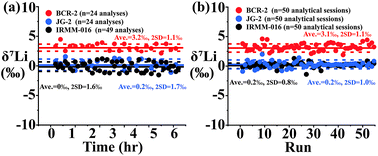Optimization of lithium isotope analysis in geological materials by quadrupole ICP-MS
Abstract
This study develops and optimizes a new protocol to measure lithium isotope ratios using a single collector quadrupole inductively coupled plasma mass spectrometer (Q-ICP-MS) operated under hot plasma (1550 W) conditions with a sample–standard bracketing method. Our Q-ICP-MS method reduces sample consumption to 2.5 ng of Li and achieves a high long-term precision of 1.1‰ (2SD). This Q-ICP-MS method exhibits high matrix tolerance (Na/Li < 100), suitable for ng-sized and high-matrix geological samples. We also developed a dual-column system for Li separation, with large loading capacity (29.6 meq), complete recovery (∼100%) and satisfactory purification (Na/Li m m−1 < 1), as well as a fixed elution range for Li fractions (28–60 mL). This new chromatography method has been applied to chemically diverse materials, producing consistent results. In addition, we report the Li isotope compositions of 13 geostandards, and our measurements agree well with reported data within analytical uncertainties. This study documents that Li element concentration and Li isotope composition can be routinely measured using a single collector ICP-MS, which is convenient and commercially affordable for future Li isotope research across the fields of Earth and Environmental Sciences.



 Please wait while we load your content...
Please wait while we load your content...